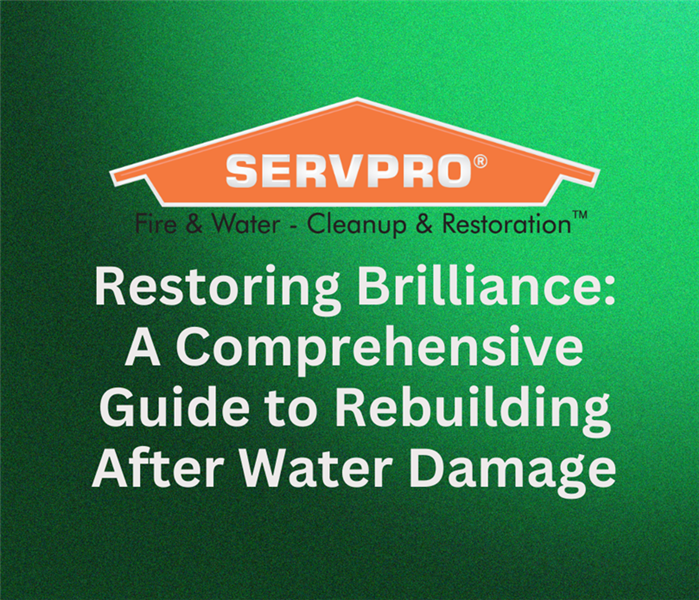Restoring Brilliance: A Comprehensive Guide to Rebuilding After Water Damage
7/7/2023 (Permalink)
 Rebuilding a building after water damage requires careful planning, meticulous execution, and collaboration among various professionals.
Rebuilding a building after water damage requires careful planning, meticulous execution, and collaboration among various professionals.
Recovering from water damage can have devastating effects on a building, impacting its structural integrity, functionality, and overall appearance. Whether the damage is caused by floods, burst pipes, or leaks, it is crucial to take immediate action and plan the restoration process carefully. Let's explore a step-by-step guide on how to rebuild a building after water damage, ensuring a safe, efficient, and visually appealing transformation.
Step 1: Assessing the Damage: Before beginning the rebuilding process, it is essential to conduct a thorough assessment of the water damage. Engage the services of a professional inspector or a reputable restoration company to determine the extent of structural, electrical, and mold-related damage. This assessment will provide crucial insights to effectively plan the restoration process.
Step 2: Ensuring Safety: Safety should always be the top priority when working on a building affected by water damage. Before entering the premises, ensure that the electrical power is shut off to prevent potential hazards. Take necessary precautions to avoid slips, falls, and exposure to contaminated water. Utilize appropriate personal protective equipment (PPE) such as gloves, masks, and boots.
Step 3: Water Extraction and Drying: Removing the water is a critical step in the restoration process. Utilize industrial-grade pumps, wet vacuums, and dehumidifiers to extract standing water from the affected areas. Promote proper air circulation by opening windows, using fans, and employing specialized drying equipment. It is imperative to eliminate excess moisture to prevent mold growth and further damage to the structure.
Step 4: Mold Remediation: Moisture-laden environments provide ideal conditions for mold growth. If mold is detected, consult with professionals experienced in mold remediation. They will assess the extent of mold contamination, perform thorough cleaning, and ensure proper ventilation to prevent future mold outbreaks. Taking prompt action will safeguard the health of occupants and maintain the integrity of the building.
Step 5: Structural Repairs: Once the affected areas are dry and free of mold, it's time to address the structural damage. Engage the services of qualified contractors or construction professionals to repair weakened walls, floors, ceilings, and the foundation. Reinforce compromised structures, replace damaged materials, and ensure compliance with building codes and regulations. Conduct necessary plumbing repairs and inspections to prevent future water-related issues.
Step 6: Electrical and HVAC Systems: Water damage can severely impact electrical and HVAC systems, posing potential safety hazards. Engage licensed electricians and HVAC technicians to thoroughly inspect, repair, or replace damaged components. Ensure that all systems meet safety standards and regulations before reconnecting utilities.
Step 7: Interior Restoration: The rebuilding process also involves restoring the interior spaces to their former condition. Assess and replace damaged insulation, drywall, flooring, and fixtures. Repaint walls, applying mold-resistant coatings where necessary. Consider utilizing waterproof materials for future protection. Consult interior designers or decorators to create functional and aesthetically pleasing spaces.
Step 8: Prevention and Preparedness: To mitigate the risk of future water damage, implement preventive measures. Install water detection systems, reinforce waterproofing measures, and regularly inspect plumbing and roof systems. Educate occupants on proactive steps to prevent water-related accidents and encourage immediate reporting of leaks or other issues.
Rebuilding a building after water damage requires careful planning, meticulous execution, and collaboration among various professionals. By following this comprehensive guide, you can navigate the restoration process with confidence, ensuring the safety, functionality, and beauty of the rebuilt structure.
If you're in need of cleanup and restoration services for residential or commercial buildings affected by fire, mold, water, or storm damage, consider contacting SERVPRO Of Foxborough. They are the #1 choice in cleanup and restoration, serving Bellingham, Foxborough, Franklin, Millis, Norfolk, Wethersfield, and Wrentham, MA.




 24/7 Emergency Service
24/7 Emergency Service